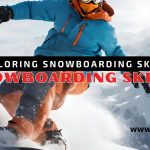Are you ready to hit the slopes and experience the thrill of snowboarding? Look no further. This article will provide you with essential tips and techniques to help you get started on your snowboarding adventure. Whether you’re a complete beginner or have dabbled in other board sports, this guide will cover all the basics you need to know.
Before you embark on your snowboarding journey, it’s crucial to understand the necessary gear for a safe and enjoyable experience. In the next section, we will delve into the world of snowboard equipment, including the different types of snowboards, boots, and bindings suitable for beginners. We’ll also provide tips on how to choose the right size and fit for your gear.
Once you’ve equipped yourself with the right gear, you’ll move on to learning the fundamentals of snowboarding. From mastering the art of balancing on the board to navigating different terrains, this section will lay the groundwork for your snowboarding skills.
Safety is of utmost importance, especially for beginners. In the section dedicated to safety, we’ll outline essential measures to follow on the slopes, such as wearing protective gear, understanding mountain rules, and learning how to fall safely. By prioritizing safety, you can fully enjoy the thrill of snowboarding without unnecessary risks.
Getting the Right Gear

When it comes to snowboarding, having the right gear is essential for a smooth and enjoyable experience on the slopes. For beginners, investing in snowboard equipment specifically designed for their skill level is crucial to ensure comfort, safety, and ultimately, progress in the sport.
Choosing the Right Snowboard
One of the first steps in getting the right gear is selecting the right snowboard. For beginners, it’s recommended to choose a snowboard that is softer and more forgiving, as these types of boards are easier to control and maneuver. Look for snowboards labeled as “beginner-friendly” or “all-mountain” to ensure versatility as you progress.
Remember, the key is to find a snowboard that matches your weight, height, and riding style. Consult the manufacturer’s size guide to determine the proper length of the board based on your body measurements.
Finding the Perfect Boots and Bindings
Aside from the snowboard itself, beginners should also pay attention to their choice of boots and bindings. The boots should fit snugly, providing both support and comfort to the feet. Look for boots with adjustable features to customize the fit according to your preference.
Bindings, on the other hand, should securely connect your boots to the snowboard, ensuring responsiveness and control. It’s important to choose bindings that are compatible with your boots and snowboard for a proper fit.
Size Matters
When selecting gear, size matters! Choosing the right size snowboard, boots, and bindings is crucial for your safety and performance. A snowboard that is too long or too short can hinder your progress, while boots that are too tight or too loose can lead to discomfort and lack of control.
Try on different sizes and models of snowboard boots to find the one that provides a snug fit without causing pressure points. Similarly, check the sizing charts provided by the manufacturer when selecting a snowboard and bindings.
Proper Maintenance
Lastly, don’t forget to take care of your snowboard equipment for optimal performance and longevity. Regularly waxing your snowboard and maintaining the edges will enhance its glide and maneuverability on the snow. Store your gear in a cool, dry place to prevent damage and ensure it stays in great condition season after season.
By investing in the right snowboard equipment for beginners and following these tips, you’ll be well-equipped to start your snowboarding journey efficiently and safely. Remember, mastering the basics and building a strong foundation in the sport will set you up for a lifetime of enjoyment on the slopes.
| Type of Gear | Recommended Brands |
|---|---|
| Snowboards | Burton, Ride, GNU |
| Boots | Burton, ThirtyTwo, Salomon |
| Bindings | Union, Flow, Burton |
Learning the Basics

In order to get started with snowboarding, beginners need to develop a solid foundation of fundamental skills. By mastering these basics, riders will be well-prepared to safely navigate the slopes and enjoy the exhilarating experience of snowboarding.
Balance and Strapping In
One of the first skills that beginners need to learn is how to maintain balance while on the snowboard. Keeping a centered stance and distributing weight evenly between both feet is essential for stability. Practicing balancing exercises, such as standing on one foot or shifting weight from edge to edge, can greatly improve balance and control.
Learning how to strap in properly is another crucial skill. Securely fastening the boots to the bindings enables riders to have full control and maneuverability on the board. It’s important to ensure that the bindings are adjusted to fit snugly and comfortably, providing optimal support and responsiveness.
Understanding Terrain and Edging
As beginners progress, they need to familiarize themselves with different types of terrain and develop the ability to adapt their riding technique accordingly. Whether it’s cruising down groomed runs or tackling more challenging off-piste terrain, understanding how to adjust body positioning and weight distribution is key.
Learning how to edge the snowboard is essential for controlling speed and initiating turns. By applying pressure on the edges of the board, riders can carve smoothly and navigate various slopes. Practicing proper edging techniques, such as angulating the knees and ankles, will greatly enhance control and stability.
Navigation and Stopping Techniques
Being able to navigate the mountain safely is an important skill for snowboarders. Beginners should learn how to look uphill and yield to other riders, ensuring a safe and enjoyable experience for everyone on the slopes. Understanding and following the mountain’s rules and signage is crucial for maintaining safety and avoiding accidents.
Learning how to stop is another essential skill. Beginners should practice using their edges to gradually slow down or come to a complete stop. Techniques such as the falling leaf or skidding turns can help riders gain confidence in controlling their speed and stopping when needed.
By focusing on learning and mastering these core snowboarding skills, beginners will establish a strong foundation for their progression in the sport. As with any physical activity, practice, patience, and professional instruction can greatly accelerate the learning process and ensure a safe and enjoyable snowboarding experience.
Safety First
When it comes to beginner snowboarding, safety should always be a top priority. Whether you are hitting the slopes for the first time or building up your skills, taking the necessary precautions will ensure a fun and accident-free experience. Here are some important safety tips to keep in mind:
- Wear Protective Gear: Before you step onto your board, make sure you have the proper protective gear. This includes a well-fitted helmet, wrist guards, knee pads, and elbow pads. These items will provide added protection in case of falls or collisions.
- Stay Hydrated and Take Breaks: Snowboarding can be physically demanding, so it’s crucial to stay hydrated and take regular breaks. Dehydration and fatigue can affect your focus and reaction time, increasing the risk of accidents. Carry a water bottle with you and take breaks whenever you feel tired or thirsty.
- Start on Beginner-friendly Terrain: When you’re starting out, stick to slopes that are suitable for beginners. These slopes tend to be flatter and less crowded, making it easier to practice your skills without feeling overwhelmed. As you gain confidence, you can gradually progress to more challenging terrain.
By following these beginner snowboarding tips and prioritizing safety, you can enjoy the thrill of snowboarding while minimizing the risk of injuries. Remember to always be mindful of others on the slopes and respect their space. Happy shredding!
| Safety Tips | Benefits |
|---|---|
| Wear Protective Gear | – Prevents injuries – Adds confidence |
| Understand the Mountain Rules | – Avoid accidents – Promotes a safe environment |
| Learn How to Fall Safely | – Minimizes risk of injury – Builds resilience |
| Stay Hydrated and Take Breaks | – Maintains focus and energy – Reduces fatigue-related accidents |
| Start on Beginner-friendly Terrain | – Builds confidence – Allows for skill progression |
Progressing Your Skills

Once beginners have mastered the basics of snowboarding, it’s time to take their skills to the next level. By incorporating these tips and techniques, beginners can continue to improve their snowboarding abilities and gain confidence on the slopes.
Practice Makes Perfect
Consistent practice is key to progressing as a snowboarder. Set aside dedicated time each week to hit the slopes and focus on specific skills. Whether it’s perfecting turns, mastering different types of terrain, or fine-tuning balance, repetition and practice will lead to improvement.
Challenge Yourself with Different Terrain
Don’t shy away from trying new types of terrain. Experimenting with different slopes and conditions will help broaden your skillset and make you a more versatile snowboarder. Practice on groomed runs, moguls, and even terrain parks to develop your ability to handle various challenges.
Take a Lesson from the Pros
Even experienced snowboarders can benefit from professional instruction. Consider taking lessons from certified instructors who can provide personalized feedback and guidance tailored to your skill level. These lessons can help identify areas for improvement and introduce advanced techniques to take your snowboarding to the next level.
Push Your Comfort Zone
While it’s important to always prioritize safety, pushing your comfort zone within reasonable limits will help you grow as a snowboarder. Gradually take on more challenging runs or attempt new tricks to expand your skills and build confidence. Remember to progress at a pace that feels comfortable and within your abilities.
“The more you challenge yourself and step outside your comfort zone, the faster you will progress and become a stronger snowboarder.” – Professional Snowboarder
Join a Community
Connecting with fellow snowboarders can provide valuable support, encouragement, and insight. Consider joining a snowboarding club or participating in group rides to connect with other enthusiasts who share your passion. Engaging with the snowboarding community can help inspire you and provide opportunities for growth.
By implementing these strategies, beginners can continue advancing their snowboarding skills and take their riding to the next level. Remember, snowboarding is all about having fun and enjoying the thrill of the mountain, so embrace the journey and keep shredding!
Conclusion
Perseverance is key in this sport. As you progress, you may encounter challenges and obstacles, but don’t let them deter you. Embrace each hurdle as an opportunity to grow and improve your skills. Whether it’s navigating steeper slopes or trying out advanced tricks, keep pushing yourself to reach new heights.
While self-teaching can be rewarding, it’s also essential to recognize when professional instruction is necessary. Working with a certified instructor can help refine your technique, prevent bad habits, and ensure your safety on the mountain. Don’t hesitate to seek guidance if you feel stuck or want to take your snowboarding to the next level.
So, grab your gear, find your favorite mountain, and embark on a thrilling snowboarding adventure. Remember to always prioritize safety and respect for fellow riders. With dedication, perseverance, and a love for the sport, you’ll discover the joy and freedom that comes with gliding down a snowy slope. Enjoy the ride!
FAQ
Q: How do I start snowboarding?
A: To start snowboarding, you will need the right gear and some basic techniques. Begin by choosing the appropriate snowboard, boots, and bindings for your skill level and body type. Take lessons from a certified instructor to learn proper techniques for balancing, turning, and stopping. Start on gentle slopes and gradually progress to more challenging terrains as you gain confidence and skill.
Q: What equipment do I need to start snowboarding?
A: To start snowboarding, you will need a snowboard, snowboard boots, bindings, and appropriate winter clothing. Beginners should opt for a softer and more forgiving board, all-mountain or freestyle boots, and bindings that provide good support. It’s crucial to wear a helmet, goggles, layers of clothing for warmth, and waterproof outerwear. Don’t forget wrist guards and knee pads for added protection.
Q: How can I learn the basics of snowboarding?
A: Learning the basics of snowboarding involves mastering core skills such as balance, turning, and stopping. Take lessons from a qualified instructor who can teach you the proper techniques and progressions. Practice on beginner-friendly slopes, start with small turns, and gradually increase your speed and confidence. Familiarize yourself with snowboarding etiquette, such as giving the right of way to other riders and avoiding crowded areas.
Q: What safety measures should I follow when snowboarding?
A: Safety should be a top priority when snowboarding. Always wear a helmet and other protective gear, especially wrist guards and knee pads. Follow the rules of the mountain, adhere to signage and warnings, and be aware of other riders. Taking breaks when you’re fatigued helps maintain focus and reduces the risk of injury. If you’re unsure about a feature or slope, it’s best to avoid it until you have the necessary skills and confidence.
Q: How can I progress my snowboarding skills?
A: To progress your snowboarding skills, practice regularly and challenge yourself with new terrain and techniques. Experiment with different turns, such as carving and switch riding. Gradually increase your speed and try tackling steeper slopes. Take advantage of terrain parks to learn tricks and jumps. Always push your limits within your comfort zone and seek guidance from more experienced riders or instructors to improve your skills.
Q: What is the best way to start snowboarding?
A: The best way to start snowboarding is to take lessons from a certified instructor. They will provide guidance on equipment, techniques, and safety. It’s important to start on beginner slopes and progress at your own pace. Patience and practice are key. Additionally, surrounding yourself with a supportive community of fellow snowboarders can offer motivation, tips, and shared experiences throughout your journey.







